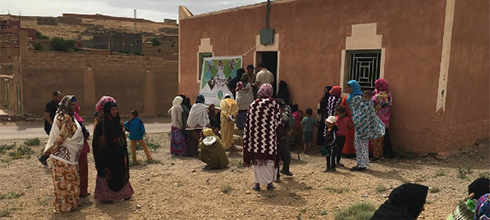
July 2016 Newsletter
For this special edition July newsletter, we are featuring excerpts of acupuncturist Mila Mintsis' recent experience of delivering acupuncture in Morocco, as written by her firsthand. Her love of the country, coupled with her desire to teach health professionals a low-cost, effective and minimally invasive treatment option for managing chronic pain conditions, serves as the inspiration for this piece:
And so it began. On May 22nd, I landed in hot and slightly musty Agadir, the resort town of Morocco. I met my team, which consisted of students from Boston at different stages of their medical training and practicing doctors and pharmacists from Agadir. Not much time was wasted and soon we were packed in cars on our way to the first village.
The process of set up was the same for each village. We would arrive late into the night, set up a clinic by unpacking all supplies and medications, determine where each practitioner would sit, and then start the next day. From the early morning hours people from the villages would start to gather outside of the clinic. Many walked long distances in a scorching heat for their possibly first and only chance to see a doctor or get any type of medical help.
Most people living in these villages have never received any education, cannot read or write, and some do not even know their own age. In each village I was given a private space where men and women could undress if needed and sit on chairs or lay on the floor. Because of religious beliefs, men and women had to be treated separately and had to wait for their turns.
For a good amount of time I was on my own, without a translator, and communicated with people with very few words that I learned. I would point to different body parts when asking where their pain was and they would immediately catch on and point to the problem area. Not only could these people not ask me any questions about acupuncture because of our language barrier, but they also could not pull out their phones, as we do here, to look up new information. And yet, all of them displayed immediate trust. I was genuinely in awe.
Patients would quietly sit in a circle or lay on the floor, often uncomfortable because of the conditions, and let the needles do their magic. And at the end they would leave with a smile, some kissing my hands and hugging me, and everyone wishing me well. My favorite moment happened in the last village. We were situated in the mountains and I was assigned a small house to treat people.
After the women were done with their turn and I was waiting for the men to come, I suddenly heard a knock on the door. I opened the door and there were about 15 pairs of eyes staring at me. A moment later, a boy age 11 or so, stepped forward, pointing to his knee. I told him to come in and he bravely stepped in while his friends looked and giggled.
The boy's name was Mohammed, and he has had knee pain for 4 months, which he mostly felt when he ran and played with a ball. I told Mohammed to show me the painful spot. After the needles were inserted, I asked him to find the painful spot again. It was no longer there. I will never forget the look of amazement and happiness on his face. And it was an incredible way for me to conclude my clinic experience.
